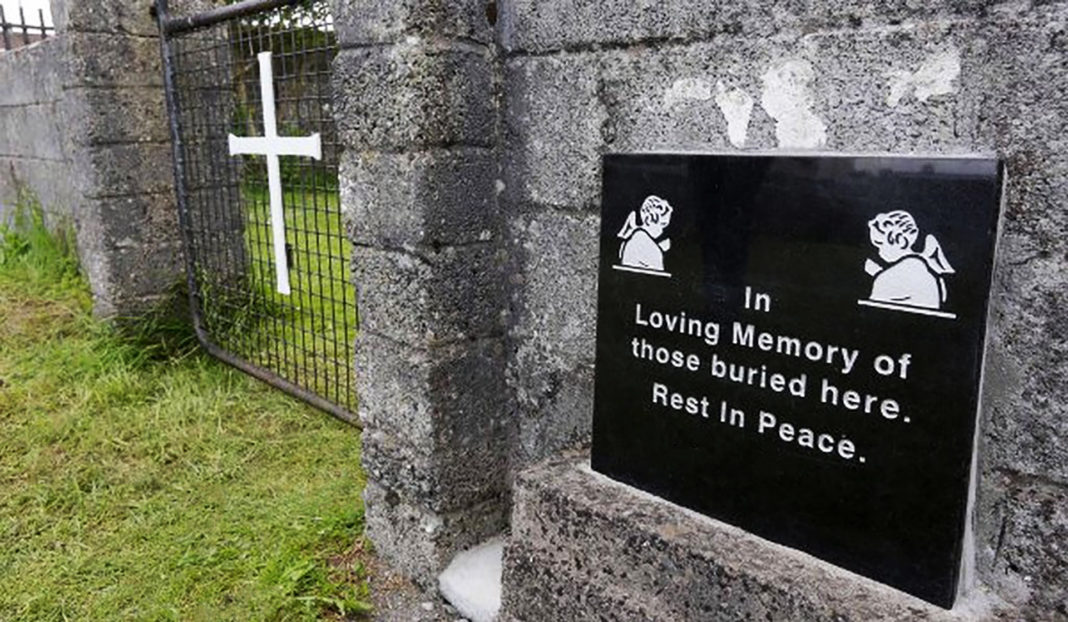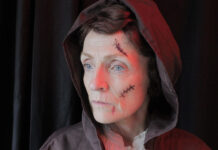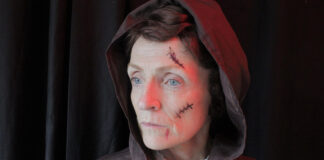It was all true. Every word. 796 babies, dumped in a septic tank in Tuam.
Last Friday, the Mother and Baby Home Commission of Investigation announced it has found “significant amounts of human remains” in what was a disused sewage system at the back of the Bon Secours Mother and Baby Home in Tuam.
As the Taoiseach said, ‘this didn’t happen in the dawn of history. This happened in our time’.
The Commission’s finding brings vindication for those who were vilified for their search for the truth.
Those who survived their time in the Tuam Home, and those who lost loved ones there, were subjected to even further pain when their stories were denied and the scale of what was done to them was dismissed or minimised.
Anna Corrigan, who grew up believing she was an only child, and whose tireless search for her older brothers John Desmond Dolan and William Joseph Dolan, sparked the Tuam Babies story, has had to fight Official Ireland for over half a decade, her every step obstructed and frustrated.
Catherine Corless, a kind and decent woman whose selfless championing of 796 babies exposed the mass grave, was absolutely vilified and called a liar, at home and abroad. This is the woman who quietly and doggedly – and at €4 a go – assembled the 796 death certificates of the Tuam Babies.
Alison O’Reilly, who broke the story nationally and internationally in the Irish Mail on Sunday, and Philip Boucher-Hayes, who covered the story on RTÉ’s Liveline and Drivetime, were condemned as sensationalists.
Conall Ó Fáthartha has worked unfailingly in the Irish Examiner on this story and on the broader issue of forced adoption. His dedication led to whispers in media circles of “Oh, he’s obsessed.”
“There are people alive today who were in that home,” says Catherine Corless. “Elderly women alive who lost babies in that home and are now wondering if these little bones are their children.
“There are men and women alive who have searched all their lives for the brother or sister they may never have met, or met briefly. This news means vindication for them but surely also heartbreak.”

Related – The Tuam Babies: Two years on, hard questions remain
When the Tuam Babies story went global, there was no shortage of deniers rushing out to condemn the story. The usual suspects were there, of course, offering their whataboutery and special pleading.
You can’t blame the Catholic Church, they said. Society was to blame too. No mention, of course, that it was the Catholic Church that shaped every aspect of Irish society.
Church and State were intertwined so you can’t blame the poor nuns, they said. Sure weren’t the poor nuns doing their best and they poverty-stricken themselves.
In 1938, when the infant mortality rate in the Tuam Home was five times that of the rest of the country, the poor nuns were paid a weekly sum of £1.62 per child. Adjusted for inflation, that’s approximately €110 a week. In context, the Children’s Allowance is today €32.30 per week.
Nothing can ever excuse brutality or neglect, but that didn’t stop some from trying. In an Irish Times opinion piece entitled “What twisted morality led to misery of Tuam home?”, Iona Institute patron Father Vincent Twomey, laid the blame squarely on “Victorian puritanism”.
Well, I suppose no-one ever went broke telling the Irish that it was all the Famine Queen’s fault.
On Twitter, the former Conservative MP Louise Mensch was to the forefront of an international campaign claiming the whole thing was “a smear on Mother Church”. Maybe I’m doing Twitter wrong, but I can’t seem to find those tweets now. But that’s okay. We saved them.
Professor Diarmaid Ferriter of UCD came out in 2014 and decried “this erroneous assertion that 800 bodies were dumped in a septic tank. That is not true.”
Shamefully, and I’ll never understand why, the Irish Times joined in. Rosita Boland wrote a hatchet job which caused huge hurt to Catherine Corless and which gave great succour to those who denied the story.
That article – which the Irish Times has yet to disavow – gave cover to apologists for the Bon Secours nuns to claim that there was no septic tank on the site but – thanks to the great detective work of Izzy Kamikaze – we learned that, according to the original plans, there was actually a series of cesspits on the grounds, a Victorian system of up to twenty interlinked and vaulted chambers.
The remains of children ranging in age from 35 foetal weeks to three years have now been found in at least seventeen of those chambers.
Related – The State already knew about Tuam
When the French film-maker Saskia Weber contacted the Bon Secours Sisters in 2014, she got a reply from their PR advisor, Terry Prone of the Communication Clinic, making light of what she called the “O my God mass grave in West of Ireland”.
Ms Prone told Ms Weber “If you come here, you’ll find no mass grave, no evidence that children were ever so buried.”
Ms Prone happened to be on the Today With Sean O’Rourke show last Friday just as the Commission’s findings broke. She rather weakly conceded “there appears to be a whole lot more to it…
“Nobody expected the kind of numbers that are being revealed today. Clearly there was extensive burial.”
There was indeed, and that was confirmed by Sister Marie Ryan of the Bon Secours in her 2013 letter to Anna Corrigan, where Ryan acknowledged what she called “a general grave” behind the Tuam Home.
“I note that (John Desmond) unfortunately died on 11 June 1947 and the death certificate seems to indicate that the place of death was at the Home. As I understand it there would therefore be a very good possibility that his remains were buried at the small cemetery at the Home itself. This is located at the back of the Home and was operated as a general grave.”
That letter, of course, flatly contradicts Ms Prone’s 2014 claims.
Last Friday, the Bon Secours order issued a bland statement that it is co-operating with the Commission. As RTÉ’s Joe Duffy noted scathingly “You would think they would have added a paragraph sympathising with the relatives”.
At the time of going to press, Ms Prone has made no further comment.
On Saturday evening, David Quinn of the Iona Institute, tweeted “I was just speaking to an historian about unmarked graves. He said they were the absolute norm once upon a time. He mentioned a Church of Ireland parish church in Dublin which was demolished in the 1970s and they found on the grounds no fewer than 7,000 skulls.”
The next morning Professor Brian Lucey of Trinity did a bit of crowd-sourcing on Twitter and, with the help of Church of Ireland Bishop of Cork Paul Colton and others, had within a few hours apparently debunked Quinn’s claims.
Bishop Colton suggested Quinn meant St Peter’s on Aungier Street, where 1,200 reburials occurred. At the time of going to press, Mr Quinn had not replied.
As Professor Lucey told me, “I’m going to be kind and suggest David Quinn mis-recalled 1,200 exhumations as 7,000 dumped bodies.”
“Dumped in a septic tank”
On the issue of the phrase “dumped in a septic tank”, Philip Boucher-Hayes notes that while the phrase “buried in an adapted crypt” might be more accurate, there is no escaping the fact that it was previously a sewage treatment system.
“It is most likely that the septic tank was properly decommissioned (or at least disconnected) before it was ever used for burials,” he says, “But it’d be naive to suggest that the nuns didn’t know what purpose it had served and the symbolism of using it as a final resting place.
“So to judge the Bon Secours order by the rules their religion sets for them, if a baby was baptised there was no reason it could not be buried in the cemetery. The records suggest the majority of babies were not stillborn but in fact under a year. You can be confident of one thing when in the care of the nuns – they’d sure as hell get you baptised lickety spit.
“So why did they prefer to bury baptised children in a re-purposed sewage facility rather than in the neighbouring properly consecrated ground?” asks Boucher-Hayes.
“The possible answers swing from attitude of casual disrespect towards their young charges, right up to something entirely more sinister. Especially as the Bon Secours were being paid the modern day equivalent of €110 (per week) per child in their care.”
“She probably would have made a perfect mother”
I watched the Six-One News on Friday evening in the wake of the announcement of the Commission’s findings.
PJ Haverty, who was born in the Tuam Home in 1951, told RTÉ that he and his mother were split up when he was one, to break the bond between mother and baby.
That makes sense. In Tuam, I’ve heard, the nuns passed babies along a battery of breast-feeding women lest mothers bond with their own babies at all.
Think about that. What kind of a mind would even think of such an evil idea?
PJ Haverty spent the first six and a half years of his life in the Tuam Home. Years later, PJ tracked down his mother in England. She died four years ago.
“I feel it wasn’t her fault,” he told RTÉ News. “It was the Church, the State and this country that let her down and I want an apology now because she didn’t do anything wrong.
“She did not do anything wrong and I want an apology from the State and the Church so as I can go back to her grave and read that over her grave, that she did nothing wrong whatsoever.
“And she probably would have made a perfect mother.”
Unmarried mothers: “the biggest crime of all”
“It’s a very black period in Irish history,” says Alison O’Reilly. “It’s one of the last dark secrets here and everybody knew about it.
“These workhouses were visible. If you were an unmarried mother, you were thrown in there by your family or by the Catholic Church, and they were run by the local county boards. These nuns got a payment for every one of the babies – and the mothers who worked in the homes – so I just don’t see why it’s taken so long to uncover this horrific past that we have.”
O’Reilly has lived and breathed this story for three years and it’s hardly surprising that she becomes visibly angry when talking about it.
“It is absolutely appalling that this happened to these little innocent children who did nothing wrong. Their biggest crime was to be born – or not born, some of these children are 35 weeks in their foetal (development) and their mothers were just not married.”
O’Reilly is damning on that point. The mothers were not married.
“That was the biggest crime of all,” she says.
A monstrous injustice was done here, on Irish ground and in the Irish ground, and at last that crime is exposed, and those who exposed it are vindicated.
“The tragedy now is we don’t know how many bodies are in those tanks,” says Catherine Corless. “I have found death records for 796 children, are they all there? Were some of them sent to America through illegal adoption schemes?”
“Tuam is just the tip of the iceberg,” Alison O’Reilly says. “If you speak to any of the adoption rights campaigners who have fought long and so hard to get to the bottom of the secret dealings that went on… you will find that there are just so many tragic stories.
“I think what happened with Tuam was it resonated with so many people because (of) Catherine Corless who uncovered the names of the 796 children. There’s anecdotal evidence of babies buried in unmarked graves all across the country. Any workhouse, any Magdalene laundry, any mother and baby home, has an adjoining graveyard.”
Send in the Criminal Assets Bureau
The Taoiseach is right to say “this didn’t happen in the dawn of history. This happened in our time.” For all our guff about cherishing children, Ireland has always failed its children. The case of poor Grace should be on all of our minds as we reflect on the Irish children we are failing right now.
So what happens next? Well, Alison O’Reilly reported on Monday that only two of the nuns with links to the former St Mary’s Home in Tuam are still alive. One is in her 90s. The other is in her 80s and suffers from dementia.
Garda sources say reasons for establishing a criminal investigation would be a reasonable suspicion of a crime being committed, such as homicide or neglect, but say it would be almost impossible to prove the latter after so long.
I dunno, lads. The first thing that springs to mind is that – despite its proximity to a consecrated graveyard – the Tuam septic tank is not an official burial ground. Try burying Granny at the bottom of the garden under her favourite tree and see what happens.
DNA tests will be logistically very difficult, but in the meantime, try counting the bodies. If all 796 babies aren’t there, where are they?
There is a strongly-held suspicion locally – albeit anecdotal – that an alleged child-trafficking operation was run out of Tuam. It might be hard to prove now that the children too ill to sell to wealthy Americans were actually allowed to starve to death, but as a State we surely have a duty to investigate.
Some of the mothers who were held against their will in the Tuam Home are still alive. They were coerced into working for free. Last time I checked, that was a crime in Ireland.
The nuns who presided over the horrors of Tuam are mostly gone to whatever reward there is for them, but the Bon Secours Order is still there and it’s not short of a bob or two.
Send in the Criminal Assets Bureau.
The Criminal Assets Bureau has the finest forensic accountants in the land. Go after the religious orders along the Al Capone route. If they really did sell babies, you can be damn sure they didn’t pay taxes for them.
As former Tánaiste and Labour leader Joan Burton points out, the Catholic Church has yet to live up to even the pathetic abuse redress scheme it promised Fianna Fáil all those years ago.
Don’t stop with the Bon Secours Order. Tuam is, as Alison O’Reilly says, just the tip of the iceberg. There’s St Patrick’s on the Navan Road, Bessborough, Sean Ross Abbey, Castlepollard, the Bethany Home, the Magdalene laundries, the county homes and all the others.
Send in the Criminal Assets Bureau.
Tell them they’re looking – for starters – for evidence of kidnapping, false imprisonment, enslavement, child-trafficking, criminal neglect, profiting from criminal activity and misuse of State funds.
Saint Timothy was right. Money is at the root of all evil.
Send in the Criminal Assets Bureau.








